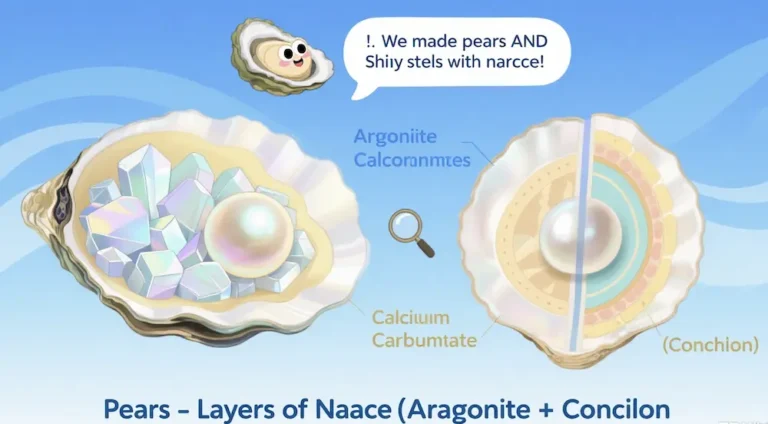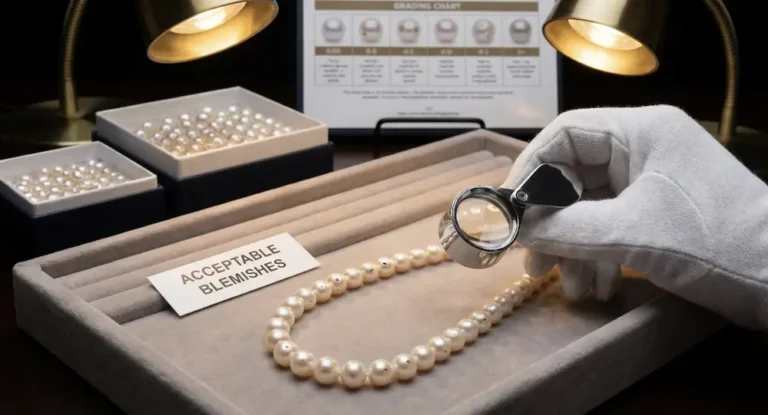Choosing the right pearls for jewelry really comes down to understanding their size. Whether you’re buying your very first pearl necklace or adding to your collection, this pearl size guide will give you the knowledge to make smart choices. There are different sizes of pearls, from tiny 2mm seed pearls to beautiful 20mm South Sea pearls, and each one has its own unique look and use.
At first, all the numbers and sizes can be hard to understand. But with a helpful pearl size chart and some guidance, you’ll quickly see how the size of a pearl affects everything, from its look and feel to its cost and when you’d wear it. Let’s get started with this interesting world of pearl sizes!
Understanding Pearl Size Basics
It’s easy to tell how big a pearl is once you know the basics. Just measure its diameter in millimeters (mm), as any pearl size chart will show you. Jewelers all over the world know about a standard way to size pearls. You can weigh or measure other gems by their length.
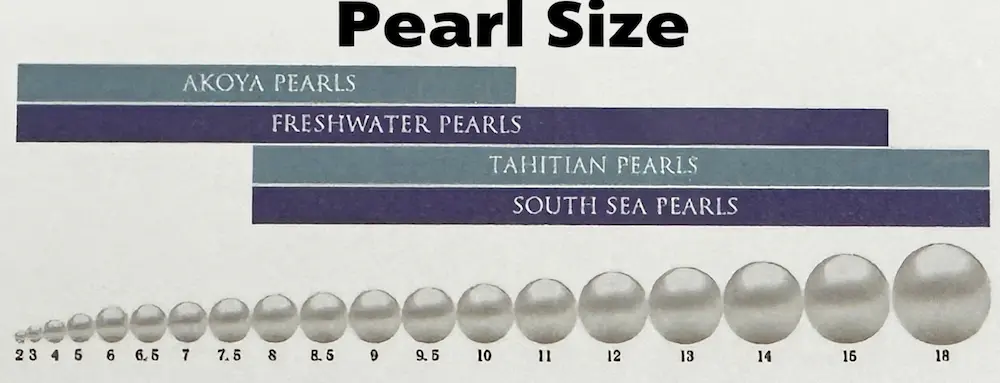
The usual categories are:
- Small pearls: Under 7mm
- Medium pearls: 7-9mm
- Large pearls: Over 9mm
These groups help jewelers and customers talk about what they want more easily, as outlined in any good pearl size guide.
Different types of pearls naturally grow to different sizes. Freshwater pearls are usually between 5mm and 13mm, while Akoya pearls are typically 6mm to 9.5mm. Tahitian and South Sea pearls are the biggest, and they can get up to 20mm or even larger!
The 12 Essential Pearl Dimensions
To help visualize pearl dimensions, here are the 12 essential pearl sizes with real-world comparisons, as shown in this pearl size chart:
- 3-4mm pearls – Match an unpopped popcorn kernel (seed pearls)
- 5mm pearls – Equal a pencil eraser diameter (delicate jewelry)
- 6mm pearls – Resemble a standard peppercorn (starter size)
- 7mm pearls – Similar to a small blueberry (popular choice)
- 8mm pearls – Match a chickpea size (classic elegance)
- 9mm pearls – Equal a standard marble (premium range)
- 10mm pearls – Match a large grape (statement pieces)
- 11mm pearls – Similar to a cherry tomato (luxury category)
- 12mm pearls – Equal a large olive (dramatic impact)
- 13-14mm pearls – Match a ping pong ball diameter (collector’s choice)
- 15-16mm pearls – Similar to a quarter coin (rare finds)
- 17-20mm+ pearls – Match a large marble to small golf ball (museum quality)
Complete Pearl Size Chart by Type
Knowing how different types of pearls fit together helps you make smart buying choices. The size range of each type of pearl depends on the species of mollusk and the conditions in which it grows, as any pearl size guide will confirm.
| Pearl Type | Common Sizes | Premium Sizes | Rare Sizes |
|---|---|---|---|
| Freshwater | 3-8mm | 9-11mm | 12-15mm |
| Akoya | 6.5-8.5mm | 9-9.5mm | 10mm+ |
| Tahitian | 8-11mm | 12-14mm | 15-20mm |
| South Sea | 9-13mm | 14-16mm | 17-20mm+ |
| Keshi | 3-12mm | Varies | Varies |
Freshwater Pearl Sizing
Freshwater pearls come in a wide range of sizes, which makes them very adaptable for different types of jewelry. As any pearl size chart will show you, people who work for a Pearl Manufacturer often suggest starting with freshwater pearls because they are a great value and come in a wide range of sizes.
Small freshwater pearls (3–6 mm) are perfect for everyday jewelry that isn’t too heavy. Medium-sized freshwater pearls (7–9mm) are the best way to show off classic elegance, while larger pearls (10mm+) are great for making a statement. You can try out different sizes of freshwater pearls without spending a lot of money because they are cheap.
Akoya Pearl Measurements
Akoya pearls are known for being more consistent in size compared to freshwater pearls. As a pearl size guide will show you, you’ll usually find them in the 6.5mm to 9mm range. Anything bigger than 9mm is considered really rare and valuable.
The pearls in a classic Akoya pearl necklace are usually between 7 and 8 mm. This gives it the classic, elegant look that people think of when they think of traditional pearl jewelry. It’s very important to make sure that all of the Akoya pearls you buy to make necklaces are the same size.
Size Selection for Different Jewelry Types
In the end, the “right” size of pearl depends on what you want to do with them and what you like. Some sizes of jewelry just look and feel better than others. It’s important to find the right balance between how something looks and how easy it is to wear, as any pearl size guide will confirm.
Necklaces and Pearl Strands
For pearl strands, the size of the pearls makes a big difference in how a pearl necklace looks and feels. Here’s a pearl size guide

Choker length (14-16 inches): Pearls that are 6 to 8 mm in size are a good choice. They look nice and sit well around your neck without being too much. Smaller pearls are also easier to wear for a long time.
Princess length (17-19 inches): This length is perfect for pearls that are 7 to 9 mm long. You can wear them every day or dress them up for a special event. This is a really popular size for most pearl necklaces.
Matinee length (20-24 inches): Pearls around 8-10mm work well here. They balance the longer length so the necklace doesn’t look too dainty.
Opera length (28-34 inches): For this dramatic, longer style, go for pearls in the 9-12mm range. The larger size makes sure the pearls still stand out along the entire length of the necklace.
Earrings
When picking out pearl earrings, you’ve got to think about your face shape, how you wear your hair, and what feels comfortable to you. As any good pearl size guide will show you, smaller pearls (5-7mm) are subtly elegant, great for work or a more professional look. Bigger pearls (8-12mm), on the other hand, can make a bolder statement.
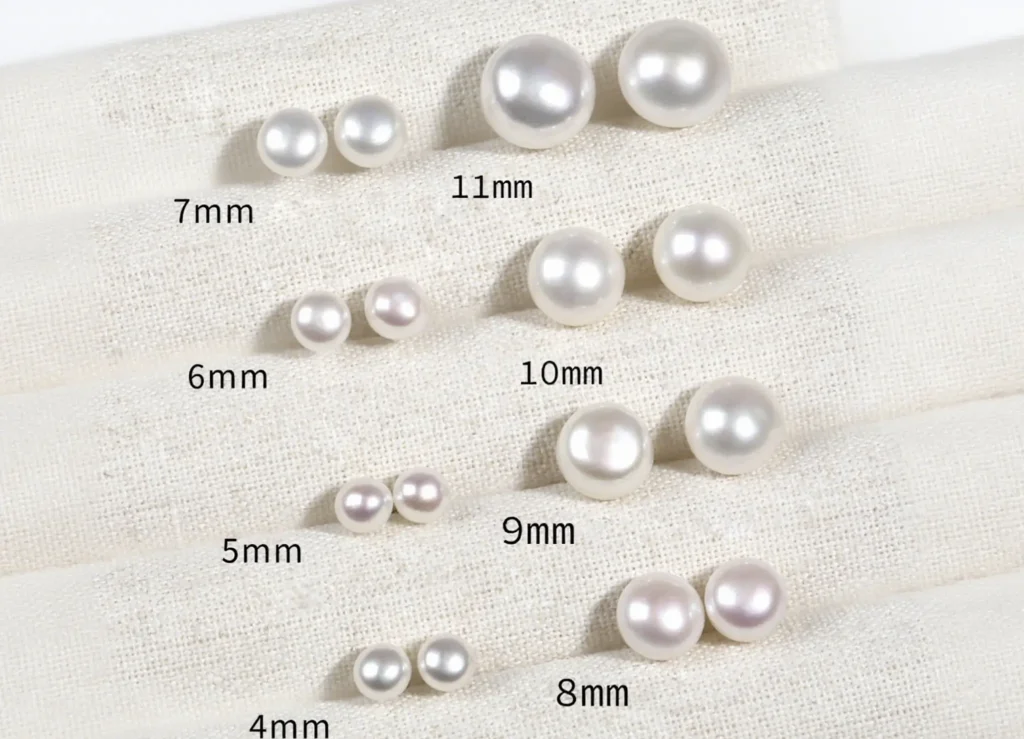
For stud earrings, jewelers try to find pearls that are almost exactly the same size (within 0.5mm) so they look symmetrical. Drop earrings might have pearls that get bigger as they go down, which helps balance the weight.
Rings and Pendants
Pearl rings usually have pearls in the 8-10mm range, as this is a good size that looks nice without being too bulky, as shown on any pearl size chart. You don’t want a pearl so big that it’s hard to wear every day.
Pendants give you more freedom with size. You can go really dramatic with a large 12-15mm South Sea pearl, or keep it delicate with a smaller 6-8mm pearl for a layered necklace.
Factors Affecting Pearl Size Preference
It’s really up to you to choose the right pearl size. It depends on your personal style, where you’re going, how much you want to spend, and your body shape. When you think about these things, you can use a pearl size guide to find the right size pearl for you.
1. Age and Lifestyle Considerations
Younger people often go for smaller pearls (5-7mm). They look great without being too much, and they’re easy to wear to school, work, or just hanging out with friends. They’re not too fancy or grown-up.
Women who are older often like sizes 8 to 12mm that make them look confident and classy. These sizes go well with both personal and professional styles and are appropriate for formal events.
2. Body Proportions
The right pearl size really depends on your body shape. If you’re petite, smaller pearls (6-8mm) often look best. If you’re taller, you can rock larger pearls (9-15mm) without them looking out of place.
The length of your neck also matters! If you have a longer neck, you can go bigger with the pearls without them overpowering you. Shorter necks look better with smaller, more delicate pearls that don’t clash with your natural proportions.
3. Occasion Appropriateness
Also, think about where you’re going. According to any pearl size chart, smaller, more understated pearls (6-8mm) are usually a good choice for a business setting. They look professional without being too flashy.
Formal events, weddings, and special celebrations provide opportunities for larger, more dramatic pearl sizes (9-15mm) that create memorable fashion statements while honoring the occasion’s significance.
Professional Sizing Tips and Measurements
To get an accurate measurement of a pearl, you need to do it the right way and have the right tools. Digital calipers are what jewelers who know what they’re doing use to get exact measurements. This way, they can make sure all the pearls in a set match and give customers the correct size information.
Measuring Pearl Diameter
If you want to know how big a pearl is, measure it at its widest point, making sure to measure across from where it was drilled if it is a drilled pearl. For pearls that aren’t perfectly round (like baroque pearls), it’s trickier. Usually, you’d write down their length and width.
Pearl experts will tell you to always measure pearls that are clean and dry, as any good pearl size guide will confirm. Oil, dirt, or even a little bit of water can throw off your measurements. This is especially important when you’re trying to find pearls that match for a necklace or earrings.
Size Matching for Strands

When you’re making a pearl necklace where all the pearls are supposed to be the same size, you’ve got to be careful about matching them up. Pros usually allow for a tiny difference of only 0.5mm between pearls in the same necklace. Really high-end necklaces have even less variation than that.
Then you have necklaces where the pearls get bigger towards the middle. These are designed so the sizes change in a specific way to make them look balanced and drape nicely.
Size Impact on Pearl Value
Of course, size really affects how much a pearl is worth. Bigger pearls cost more, no matter what kind they are. But it’s not just about the size. How good the pearl is in other ways also plays a role in the final price. It’s a combination of things.
Market Preferences
Right now, the sweet spot in the pearl market is medium sizes (7-9mm). They give you the best bang for your buck, looking great without breaking the bank. Whether you’re just a casual pearl lover or a serious collector, these sizes are a good deal.
Super big pearls (15mm and up) are more for collectors or people who want to make a bold statement with their jewelry. But they’re a smaller, more specialized market with their own pricing. The Gemological Institute of America says that the price jumps big time as you go above certain sizes. It’s not a smooth, gradual increase.
Investment Considerations
If you’re thinking about pearls as an investment, size is a big deal, but so are other things like quality. Rare sizes in really good pearl types tend to go up in value more consistently than common sizes, which makes them appealing to people who collect for the long haul.
The International Pearl Association also points out that when you find exceptionally large pearls, no matter the type, collectors get interested, and they tend to hold their value even when the market changes.
Modern Trends in Pearl Sizing
Jewelry design these days is all about using different pearl sizes. It’s moving away from the old way of using just one size and getting more creative with mixing them up. This lets you express yourself and still keep that classic pearl elegance.
Mixed-Size Designs
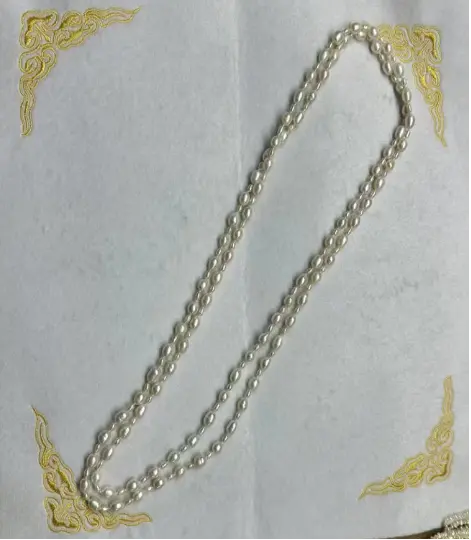
More and more, designers are putting various pearl sizes together in one piece. This creates interesting textures and a modern look. It’s against the rules to stick to one pearl size, but it’s letting you be creative in all kinds of new ways, as this pearl size guide can help you discover.
Younger people who want jewelry that is one-of-a-kind and personal really like designs that aren’t perfectly symmetrical and use different pearl sizes. These pieces often use a mix of different kinds and sizes of pearls to make them stand out and show off your unique style.
Minimalist Approaches
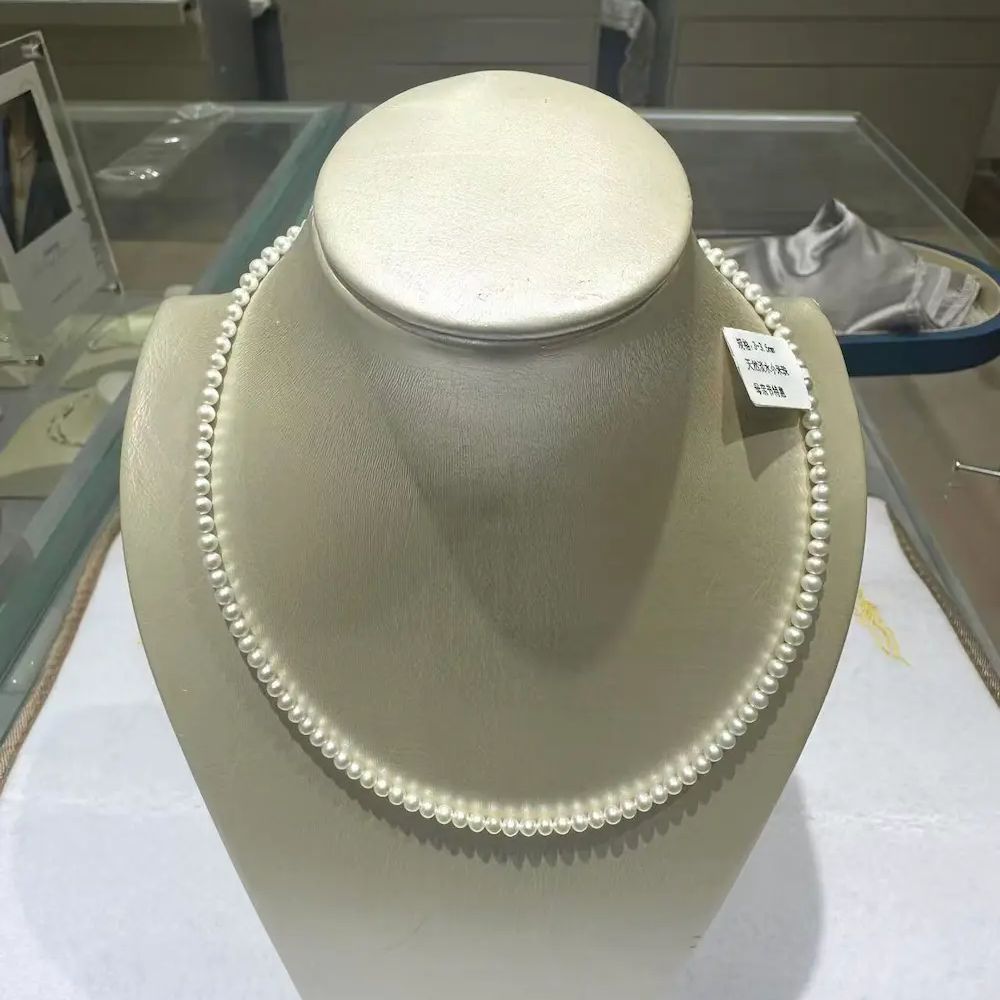
The minimalist jewelry vibe is all about smaller pearls (2-5mm). They’re perfect for layering and wearing every day. With these pieces, it’s more about the quality – the shine, the color, and how well they’re made – rather than being big and showy.
Single-pearl designs, like on necklaces or earrings, really let the beauty of each pearl shine without you getting hung up on the size. These pieces usually use really nice pearls that are a moderate size, showing off their natural features.
Care Considerations by Size
And just a heads-up: different pearl sizes need slightly different care. Bigger pearls have more surface area that could get damaged, while smaller pearls have their own issues, like making sure they stay securely in their setting and handling them carefully.
Storage Requirements
When it comes to larger pearls, you’ll want to give them enough space to prevent them from bumping into each other and getting scratched. Individual pouches or compartments are great for keeping them separate, protecting their surface quality over time.
Smaller pearls, especially in pieces with multiple pearls, need a close look at how secure the clasp is and how well they’re set. Regular check-ups by a professional will make sure they’re mounted securely and won’t fall out while you’re wearing them.
Cleaning Protocols
The way you clean pearls is basically the same no matter how big they are. However, larger pearls might need a bit more attention since they can pick up more residue. A soft, damp cloth will keep them shiny without hurting them.
If you have some big, valuable pearls or a piece with a complicated design and pearls of different sizes, you should definitely have them cleaned by a professional. It might be risky to clean them yourself at home, or you might not get them as clean as you want.
FAQs
How to determine pearl size?
Measure the diameter in millimeters with a ruler or caliper; round pearls are sized at their widest point.
What size of pearl should I buy?
7–8 mm is the everyday sweet spot; go bigger for drama, smaller for subtle.
How big is a size 7 pearl?
About the size of a peppercorn—classic stud that shows up without shouting.
Are 9mm pearls too big?
Not at all—9 mm is bold but still office-friendly; anything above 10 mm starts to feel red-carpet.
Conclusion
With the right information, you can easily figure out pearl sizes! This pearl size guide will help you make smart choices, whether you’re buying your first pearls or adding to a collection.
Ultimately, the best pearl size for you comes down to what you personally like. This pearl size chart gives you pro insights and industry standards, but your own comfort, style, and what you plan to use the pearls for should be your guide.
Pearls are beautiful because they’re so diverse, and size is just one piece of the puzzle. Whether you go for delicate 5mm freshwater pearls or stunning 15mm South Sea ones, each size has its own unique perks and timeless elegance.
It’s also a great idea to chat with pearl experts who can show you different sizes in person and give you personalized advice based on what you’re looking for, what you like, and your budget. Investing in that kind of guidance will make sure you’re happy with your pearl choices for years to come.

